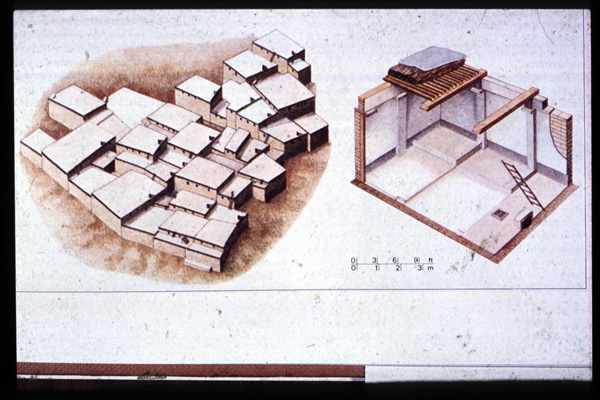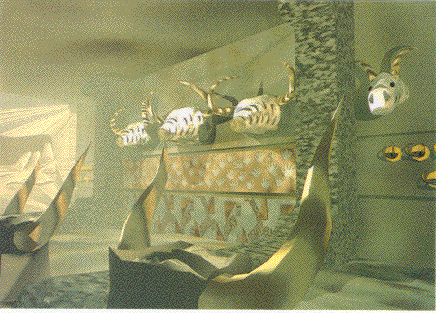 Reconstruction of
an excavated part of Catal Hoyak with detail of an individual "house"
Reconstruction of
an excavated part of Catal Hoyak with detail of an individual "house"
Archaeology began as a hobby of the rich and eccentric and as a result there is a current explosion of revelation about ancient lives based not only on new discoveries, but re-examination of prior ones as each layer of cultural bias is removed from those who study the past. Some of the cherished myths of the past are only now being understood as pure cultural imposition and in some cases, new, equally cherished myths are replacing them from new, equally flawed, motivations. The last trap is that in the attempt to view as dispassionately and bias free as possible, some understanding is lost from failure to see clear links and commonalties. Some bias is so ingrained that it becomes almost impossible go beyond them. Among these blind spots are gender and sexual morality. There are very real differences in the sexes that tend to be expressed in societies, but key to understanding the past is the importance of that word "tend". An inclination is not a guarantee of a certain pattern or result.
There is a very real tendency for humans to think in linear patterns, seeing themselves as the result of progression and progress to an ideal state of being. This was just as true of ancient historians as it is of today's and much of our ingrained misunderstanding of the past is over reliance on accounts of ancient historians writing from their own cultural blindness. But yet another trap is the wish of some to see the past as an Eden lost to patriarchal thinking. Modern feminists historians and many transsexuals are guilty of this type of thinking. Supposing a lost world-wide civilization of peaceful people ruled by women and where transsexuals were not only accepted but beloved and treasured, they are just as blinded as the most dogmatic christian historian who imposes his ideals and morality on the past. As is so often the case, the truth probably lies somewhere in the middle.
Our understanding of the Neolithic world has been turned on it's ear in the past thirty or so years. Every year the clock gets turned back further and further about the dawn of civilization as we think of it. Despite the recent educational turn away from a liberal education, a true interdisciplinary approach is being used more and more at digs such as Catal Hoyuk as it is being done rather than after the fact. Let us now start from some things we do know about the ancient world and some we know about human nature and try to reach a new understanding free of our own desires and bias about transsexuals and the Goddess in the distant past.
First, a healthy dose of reality. Men and women are different. Their brains function differently, process information differently and give each different strengths and weaknesses. This we know from medically research using tools only recently available to us. Often overlooked, however, is the variation within each category that leaves some individuals more towards the centre of the differences than to the "ideal" edges. Overlooked as well is that radical departures from these differences are also a normal part of human diversity. Intersexed and transsexual births are as equally a normal part of the human condition, if much rarer, than so called normal male and female births. They were always a part of human reality. Ok, we have a beginning point of understanding. From recent discoveries, we've learned that hunter gatherer cultures were not always nomadic. Catal Hoyuk was such a culture that combined hunter-gatherer activities with domestication of some animals within the frame work of a very large metropolitan, almost even by modern standards, settlement. A far cry indeed from the past perceptions of neolithic people living in huts or caves.
 Reconstruction of
an excavated part of Catal Hoyak with detail of an individual "house"
Reconstruction of
an excavated part of Catal Hoyak with detail of an individual "house"
Because of differences in physiology, tasks within a hunter-gatherer culture are divided mostly along the lines of sex. With the male brain pattern of focused, single minded attention and the physical traits ability for spurts of strength, hunting is more natural for males than females. Conversely, the female brain pattern that gives greater ability to multi-task combined with physiological greater stamina at lower levels of effort making women much better at gathering activities. There was overlap in these abilities and from paintings we see the occasional woman involved in hunting parties. These differences lead, in some cases, even to the development of separate languages for the sexes such as in ancient Sumeria where Emesal was the language of women and Eme-ku the language of males. As any modern transsexual would expect, the records show that the Assinnu (transsexual priestesses) of Sumeria spoke Emesal which was said to be a direct gift of Inanna.
Hunting and gathering are both equally important tasks for the survival of the community. Hunting tends to take the males away for prolonged periods, especially as the game closer by became somewhat scarcer. A transsexual individual in such a culture would likely prefer to stay with the women engaging in the more natural, to them, activities, but more importantly, that transsexual would be more likely to make the leap to the idea of staying at home and still providing meat by domestication of some animals! Today we know that despite the cultural invisibility of transsexuals, we are two full standard deviations above the mean in intelligence and creativity. The domestication of animals as an invention of transsexual women would explain much about their later, almost universal, role as religious leaders in a Goddess religion as well as the strong connection between cattle (bulls in particular) and Goddess worship throughout the ancient world. A woman identified transsexual providing not only meat, but milk and eggs as well, would have tipped the balance of contribution of resources towards women since gathering of grain to fed the livestock would still have been dependant on women as the would the care of that livestock depended on staying near the settlement, the women's role. The male contributions would have been now a variety of diet and more of a luxury than a necessity. The natural focus of such a society towards the Divine would more likely have been feminine rather than masculine. Further evidence of the connection between transsexual priestesses, the gathering activities of women and the relationship to animal domestication comes in the surviving recipes for "sacred food" prepared exclusively by the transsexual priestesses of Cybele and Inanna. They are mixtures of milk or cheese with cream, ground nuts and seeds and spices and are referred to as the most ancient of Her sacred foods. A combination of the fruits of gathering, rather than cultivation, with the milk products of cattle raising. Could the exclusiveness of this preparation be a remembrance of the contributions of transsexual women?
From Catal Hoyuk we have the first representation of Cybele, recognizable
by Her seated position flanked by two large cats found inside, not unexpectedly, a grainery bin. This is the type
of association we could expect in a society that depended more on the efforts
of women for essentials.
found inside, not unexpectedly, a grainery bin. This is the type
of association we could expect in a society that depended more on the efforts
of women for essentials.
 Reconstruction of the
bull "shrine" found at Catal Hoyuk
Reconstruction of the
bull "shrine" found at Catal Hoyuk
The strong connections of Goddess worship with certain symbols cannot
be denied. When raising cattle, the bulls become the excess available
for meat since the cows are needed both for milk production and reproduction.
For a people whose mundane and spiritual lives are intertwined, it would
only be natural for the slaughter of bulls to become ritualized and the
resulting meat a Divine gift. A gift of the Divine feminine...........the
Goddess. This explanation answers, for me, a question that puzzled
me for years.... why bulls in connection with the Goddess? Other
connections are much easier to understand, but among the almost universal
symbols associated with the Goddess in Her various forms, the connection
with bulls was one I never found a reasonable argument for and yet it is
one of the most enduring connections, lasting all the way into the late
Roman period. Could this be the answer? Before you dismiss
the idea of the domestication of animals being an invention of transsexuals,
bear in mind that our contributions to mankind, while often overlooked,
are very real even today. It was a transsexual woman, Lynn Conway,
who made the breakthrough in technology that gave birth to the modern computer
age. It was transsexual women who wrote much of the software that
took that breakthrough to it's current state. A transsexual woman,
Wendy Carlos, gave us the first real electronic music. Even the basic
electronic ringer in today's telephones was developed by a transsexual
woman. While we may be mostly invisible in today's culture, we still
have a large impact.